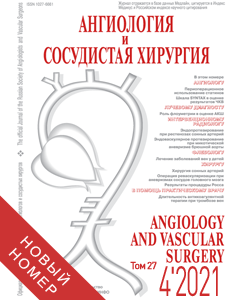Journal «Angiology and Vascular Surgery» •
2016 • VOLUME 22 • №1
Ways to improve immediate and remote results of carotid endarterectomy
Kuzhuget R.A., Karpenko A.A., Kamenskaya O.V., Ignatenko P.V., Starodubtsev V.B., Postnov V.G.
Centre of Vascular and Hybrid Surgery, Novosibirsk Scientific Research Institute of Circulatory Pathology named after Academician E.N. Meshalkin under the RF Ministry of Public Health, Novosibirsk, Russia
The authors analysed the results of carotid endarterectomy in a total of 469 patients with the use of simultaneous assessment of the oxygen status and collateral blood flow of the brain in order to determine feasibility of placing a temporary bypass, carried out at the Centre of Vascular and Hybrid Surgery of the Novosibirsk Scientific Research Institute of Circulatory Pathology named after Academician E.N. Meshalkin in 2008-2012.
It was shown that it is more appropriate to use a temporary bypass based on simultaneous assessment of the oxygen status and collateral blood flow of the brain: in synchronous decrease of the degree of cerebral oxygenation during tentative occlusion by more than 20% of the baseline level, or in absolute values of cerebral oxygenation below 40% and simultaneous decrease of retrograde pressure below 40 mm Hg. It was determined that simultaneous assessment of tolerance of the brain to ischaemia significantly decreased the incidence of using a temporary bypass from 16 to 3% (χ2=22.51; p<0.00001), accompanied by a tendency towards a decrease in the incidence of perioperative stroke from 2.6 to 0.8% (odds ratio 0.30; 95% CI 0.06–1.55; p=0.15).
Long-term results of carotid endarterectomy after 4 years showed that a decrease in the number of temporary shunts did not influence cumulative survival (log-rank test; p=0.73), the incidence of stroke (log-rank test; p=0.68) and patency of the reconstructed carotid arteries in the remote period (log-rank test; p=0.70). It was determined that in the remote period of carotid endarterectomy restenoses of reconstructed carotid arteries were encountered statistically significantly less often in the group of eversion carotid endarterectomy as compared with classic carotid endarterectomy (OR 0.23; 95% CI 0.07–070; p=0.009) and with prosthetic repair of the internal carotid artery (OR 0.13; 95% CI 0.02–0.83; p=0.03).
KEY WORDS: carotid endarterectomy, temporary bypass graft, retrograde pressure, cerebral oxygenation, cumulative survival, restenosis.
P. 117
ARCHIVES MAGAZINE
2021 (Vol.27)
2020 (Vol.26)
2019 (Vol.25)
2018 (Vol.24)
2017 (Vol.23)
2016 (Vol.22)
2015 (Vol.21)
2014 (Vol.20)
2013 (Vol.19)
2012 (Vol.18)
2011 (Vol.17)
2010 (Vol.16)
2009 (Vol.15)
2008 (Vol.14)
2007 (Vol.13)
2006 (Vol.12)
2005 (Vol.11)
2004 (Vol.10)
2001 (Vol.7)
2000 (Vol.6)
1999 (Vol.5)
1998 (Vol.4)
1997 (Vol.3)


